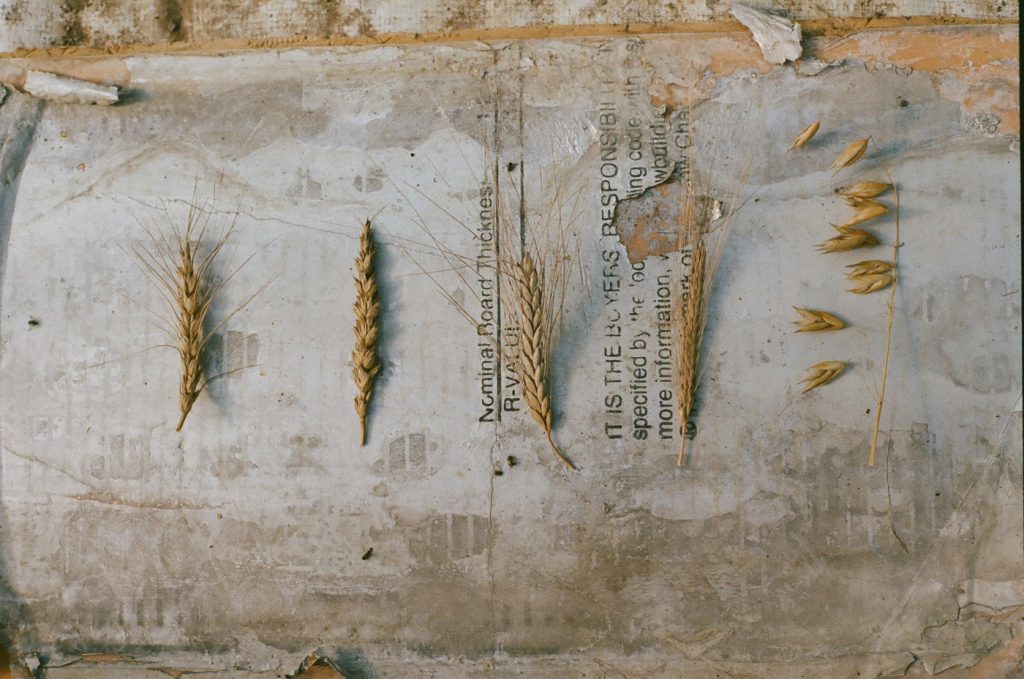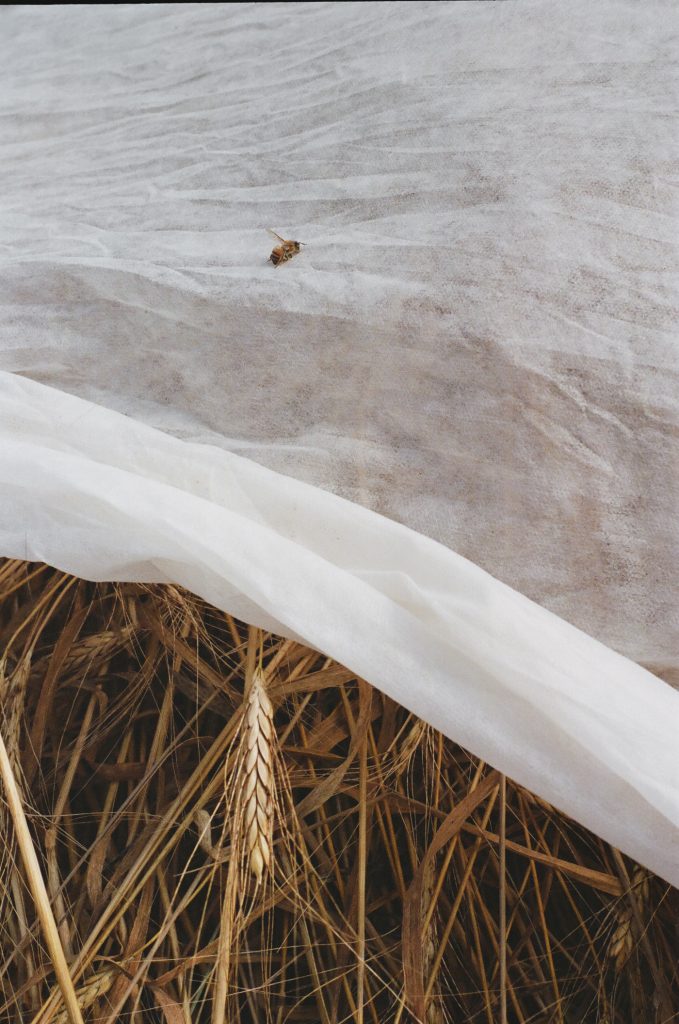Domesticating us
To begin at the beginning I’ll need to begin with my recent past. On the second day of April I planted six varieties of grain in a 100 foot plot with very little forethought. Despite this, the growing season took little labor save regular weeding sessions throughout the Spring, which served mostly as respite in the pandemic season of deep uncertainty and existential angst. In mid-July I harvested the entire plot by hand with a sickle and left the grain in a greenhouse for two weeks to dry.
Histories of early peoples link the dawn of society-as-we-know-it directly to the adoption of fixed-field grain agriculture as a way of life. Living now in a state of estrangement from our means of making and consuming food, these nascent organized communities read, bathed in the rear headlights, like a kind way to live. They feel just primitive and just modern enough, the result of a logical switch to a life of sedentary agriculture from the nomadic foraging tradition that preceded it, not yet corrupted by a global capitalist technocracy.
Many of these stories of ancient grain cultivation begin with the communities that domesticated cereal crops in the Fertile Crescent some 6000 years ago, and the coinciding evolution of humans into citizens, of populations into the body politic, of land into property, and of plants into crops. But was man’s mastery over nature through systems of control and production a necessary innovation in human progress, or a dovetailed rubicon out of eden? This birth of society coincides smoothly with the birth of the state, and grain was the key to the city.

As the time neared to begin processing my grain into a usable form, anxiety over the volume of material I was working with – a whole greenhouse worth of dried grass – and the amount of manual labor required to extract food from it, began to pay me visits. Little input had been necessary for so much material output, but the food was unavailable without plenty more time and resources – mental and physical, human and material.
Thousands of years ago, as now, a good harvest of a modestly-sized plot could produce enough grain to last a family a year. It had to be stored, but once cleaned and ready for use, grain has a high value proportionate to its volume. This storability and compactness have been written as advantageous for the farmer, but look closely and we can find the first example of true surplus, a perfect form for state seizure and taxation. Add to this the predictability of grain harvesting, which is generally done in one day, and officials of the early state could arrive onsite right on schedule to collect their share before farmers had the opportunity to consume, disperse, or hide their grain.
On the second day of April I planted six varieties of grain in a 100 foot plot
On the last morning in July I drove to a hardware store twenty minutes away and bought a large blue tarp and two sizable bins, one made of heavy aluminum and the other a thick black plastic with yellow rope handles. This trip marked the first time I drove anywhere by myself in my entire life. A belated self-sufficiency pulsed through me. When I returned from the hardware store I set up the materials I’d bought for threshing wheat. Threshing, the act of knocking the heads of grain off their stalks, is the first step in the production line of grain processing after the harvest has been thoroughly dried. I swept the ground in a far leafy corner of the greenhouse and lay my new tarp down on it. It was around 100 F degrees in the greenhouse. I chose to start with the easiest grain to process, a modern bread wheat variety that has been bred for resiliency against pests and an unpredictable climate, positive baking properties, and advantageous crop qualities like a loose hull (the papery hood that holds the kernel to the stalk), like many contemporary varieties. I worked on hands and knees, rubbing the seed heads between my flattened palms and the bright blue tarp, its surface quickly tattering from the friction. The wheat berries rained from their cocoons as I took all measures possible to disturb them, but the hulls and awns (spiky whisker-like things that jut out in a halo around the seed head) were sharp and unrelenting, battering and puncturing my fingers and palms. Sweat, blood and wheat mingled on the floor below me.
Archaeologists can tell if a woman was part of a grain cultivating community (as opposed to one that foraged) by examining her bones. Women’s knees, backs and toes bear the marks of strain and injury endured over lifetimes hunched and pressed to the ground in servitude to the threshing and grinding of grain. The physiological condition of ancient humans was distinctly reduced and degraded (especially for women, who upon entering into an agricultural state either by force or, less likely, free will, essentially became service vehicles for reproduction and were likened, like all enslaved people, to tools and cattle). Birth rates went up to account for a similarly accelerating mortality rate, one of many results of crowded and unsanitary living conditions in condensed proto-urban dwellings, and the malnourishment that came along with this first example of humans’ cleavage from nature. A stark tapering of diet and daily experience funneled the mind and the body into a single lane, with repetitive production tasks and cereal grains taking the place of the kaleidoscopic behaviors and foods that a diverse pre-agricultural lifestyle entailed and allowed. Through domestication (first of nature by man, and then of man by man’s nature) life itself was organized through labor and hierarchy.
Sweat, blood and wheat mingled on the floor below me
Kneeling on the floor is not the best way to thresh the wheat. My knees rolled over rogue kernels every second minute and my hands were torn raw from the mechanistic beatings of threshing against the ground. In several hours I’d made just a small dent in the harvest, but still I felt fulfilled. I’d missed this deceptively satisfying exchange of ease for quantifiable progress. Over the previous few months time had slipped from a web that distinguished between productivity and vacancy to one that held neither, nor anything else, firmly. Here I was, doing something. But the weight of the wheat’s labor was undeniable.


The merits of early agriculture rely in part on the barbarian myth, which implies that citizenship civilizes man. The term barbarian originates from the Greeks, and was based on their phonetic interpretation of the foreign tongue (in their telling, baba was what it sounded like when anyone else spoke). In the Epic of Gilgamesh, the barbarian Enkidu consumes only flesh and milk from wild animals, and is unfit for a proper life within an organized city wall until he accepts the cultured products of society, bread and wine, along with language and the burdens and rewards of citizenry. Only then will he transition from beast to man. Grain was the harbinger of civilization, but bread was both the gift of and latchkey to society. Grain was commodity, bread was ideology.
The second day of work brought a quick evolution: I found a new means of threshing using a mesh-topped metal table with a tarp draped below it. I carted load after load of grain from the greenhouse to my new worksite just outside its walls, stationed under a sweltering tarp canopy. I rolled the grain over the steel mesh for the better part of a full day, debris and kernels falling onto the tarp below, leaving behind a pile of straw that I gathered as I went and stacked in a tower beside the work table. This increased level of efficiency read to me as a kind of success, despite simply allowing for more work, more quickly. I was covered in pieces of the plant, its body turned to dust on mine. Each demolition of a grain head between tabletop and palm melded a wink of initial satisfaction with the onset of repetition’s novocaine, boredom tied to rhythm, a duet that propagates itself.


Grain was cultivated in moderate quantities long before it became the dominant and dominating food source of a civilized world. Cereals made sense when included in a diverse rotation of dietary sources, but a life-giving plant can become a labor-intensive crop. Due to a global shift towards warmer temperatures around 4000 BCE , the climate grew more arid and communities began to concentrate themselves around diminishing naturally irrigated areas. Less land was suitable for living well, which meant demand for certain territories was higher. Wealth arose from poverty, as groups with resources dominated the well-watered areas and leveraged this access over those without. Dense centralized locales meant a lot of things- the birth of state identity and more bodies to feed with fewer resources, to name two. Sustaining the masses (now a source of labor i.e. wealth and military power) was essential for a state to maintain control, and was easiest with large reserves of storable food that could be rationed as deemed necessary. Growing food became work, and food itself became currency.
This birth of society coincides smoothly with the birth of the state, and grain was the key to the city
After two days of threshing I was left with a pile of what looked like shredded wood chips and dried leaves. There was evidence of work but not of product nor profit. Only when I ran my hand through the mess did I uncover small golden wheat kernels, perfect and hard as little rocks, dispersed throughout the ocean of refuse. In order to arrive at anything edible from grain, the threshed kernels must first be cleaned of chaff, the variety of papery debris that surrounds them on the stalk. This step is called winnowing, and it’s accomplished by pouring grain from one vessel to another in a breeze. Just like that, the chaff will blow away, leaving the kernels naked and clean in the bucket below. After such manual toil I found it hard to believe that a passive and invisible force could do the necessary work for me, but I poured the load slowly from one vessel to the other and watched it transform. I’d never seen an invisible nuisance become a traceable utility so quickly as the wind did just then. The volume in the buckets diminished as the visible value increased, and after many rounds of pouring I was left with a pile of dusty grain and some stubborn leaves and debris. I dug through the pile over and over again, lifting and dropping the grains in heavy handfuls, and I felt its power acutely: the potential and the sensation of wealth.
| Photography | Lexie Smith |
| Words | Lexie Smith |

